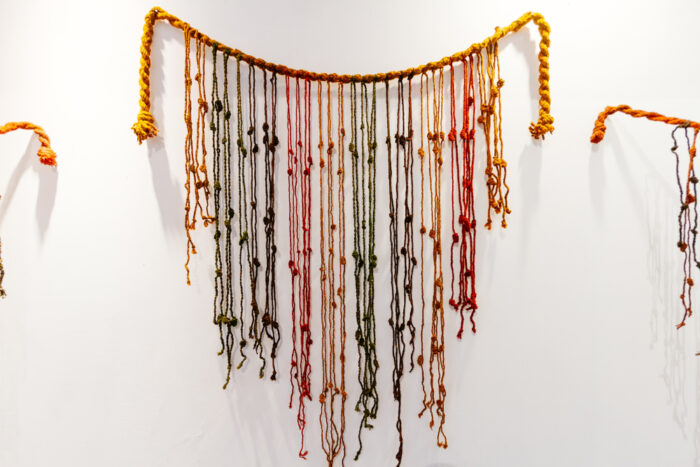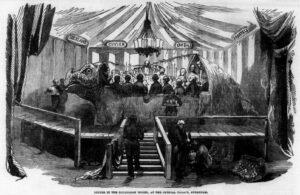Long before Spanish colonization, the indigenous people of Peru kept track of important dates and numbers, and perhaps even stories, using a mysterious coding system of strings and knots called a quipu.
When the Spanish invaded, they decided these bundles of strings and knots were idolatrous and pagan, in opposition to the Catholic Church. They burned them, hoping to quell any thought of resistance.
How does it work?
Quipu means knot in Quechua, the dominant indigenous language in the region.
You might mistake a quipu for a brightly colored necklace or headdress, but it is a communication device. Unlike their Mayan and Aztec counterparts, the Incas had no written language. They used quipu instead.

A quipu in Lima, Peru. Photo: Mark Green/Shutterstock
Quipus consist of a series of colored, knotted cords made from cotton, wool, or other animal fibers. The knots and their placement on the cords represented numerical values. In some cases, it carried other information, such as dates or records of events. The use of the quipu dates back to 2500 BCE, long before the Inca Empire emerged. We still don’t know how it originated.
Deciphering quipus is tough. Its purpose and meaning can change depending on the length of the cord, the number of knots, the color, the way the cords are twisted and woven, the material, and the arrangement. While some historians think they were used almost exclusively to communicate numbers, others believe they were capable of storytelling and poetry.
Certainly, the main purpose of the quipu was to track and manage the data of populations, goods, resources, and taxes. It was the administrative tool of the empire. Each knot on the cord had a specific value depending on its position, with different knot types (such as single knots, long knots, or figure-eight knots) representing different values. The Incas used the decimal system and knots to record 1s, 10s, 100s, 1000s, and so on.
The colors of the cords could indicate categories like resources, people, or geographical locations. For example, red represented warriors or war, white represented silver, and yellow symbolized gold.
Record keepers
The quipus were managed by quipucamayocs, which means “quipu authority.” These administrators were the record keepers, accountants, bookkeepers, mathematicians, census takers, and historians of the empire. The smooth running of the empire rested almost entirely on their shoulders.
The Incas had a complex road network called the Qhapaq Ñan. All these roads led to the capital of Cusco. Endurance runners called chasquis transported quipus along these roads, resting or passing them to other runners in supply stations called tambos posted every few kilometers. Messengers could quickly carry news of an Incan victory, the death of an emperor, or details of an enemy attack from province to province.
Quipu as a weapon
After smallpox had killed the ruler Huayna Capac, his sons, Atahualpa and Huascar, battled for the throne. Atahualpa triumphed and killed his brother. To further legitimize his ascension, Atahualpa had all records destroyed. This meant burning quipus that recorded anything to do with his brother.
Atahualpa even killed the quipucamayocs. “[It was] a total renewal, what the Incas called a pachakuti or a turning over of time and space,” historian Mark Cartwright wrote.
Later, a Spanish governor of Peru, Vaca de Castro, tried to find quipucamayocs to teach him about the land. Eventually, he came across two who had survived the purge. “They found them wandering in the mountains, terrorized by the tyrants of the past,” according to historian John A. Yeakel.
Spanish response
Though the Spanish destroyed many quipus, some chose to study them. Inca Garcilaso de la Vega was the son of a conquistador and an Incan prince, and acted as an intermediary between the two peoples. He learned about the quipu as part of his upbringing and wrote extensively about them:
When my father’s Indians came to town on Midsummer’s Day to pay their tribute, they brought me the quipus; and the curacas [local leaders] asked my mother to take note of their stories, for they mistrusted the Spaniards, and feared that they would not understand them. I was able to reassure them by re-reading what I had noted down under their dictation.
Likewise, a rogue Jesuit priest named Blas Valera advocated for learning from the quipus. Also half Spanish and half Inca, Valera proclaimed that the Incas were the real rulers of Peru. He died under house arrest in 1597.

A multicoloured quipu. Photo: Simon Mayer/Shutterstock
Threads of a story
In 2015, anthropologist Sabine Hyland got a call from the remote Andean village of San Juan de Collata. This little village held some of the last remaining quipus.
Villagers granted Hyland access to two quipus from the 18th century. They told her that for years, guarding the quipus was a coming-of-age ritual for local adolescent boys. After seeing one of Hyland’s documentaries, the village elders had reached out, hoping she would visit.
“Over the next couple days, we would learn that these multicolored quipus, each of which is just over two feet long, were narrative epistles created by local chiefs during a time of war in the 18th century,” Hyland wrote.
The elders recounted the story of a failed rebellion against the Spanish. A leader, betrayed by his associates, was imprisoned and eventually executed. He had used the quipu to tell his countrymen that he was the ruling Inca Emperor.

Illustration of an Inca with a quipu. Photo: Vanessa Volk/Shutterstock
Not far from the village of San Juan de Collata, Hyland was invited by a local schoolteacher to examine a hybrid quipu. The hybrid was set on a wooden board containing a ledger of names and multicolored quipu threads.
“The board bears the names of villagers, while the quipu cord associated with each name indicates the contribution of labor and/or goods that the individual was expected to provide in a community ceremony,” Hyland wrote.
Much to Hyland’s astonishment, quipus were used in the village until the 1940s for communal, administrative, and record-keeping purposes.





